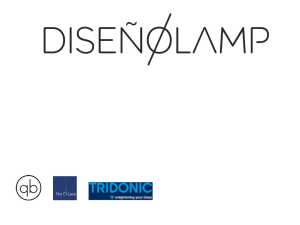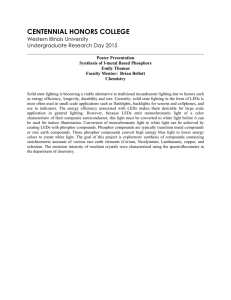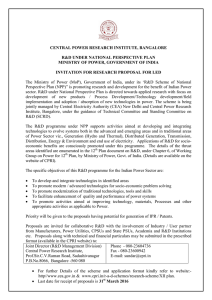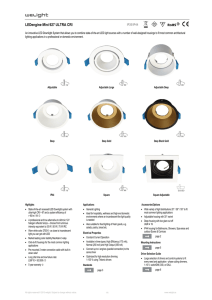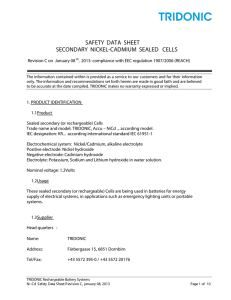LED light sources
advertisement
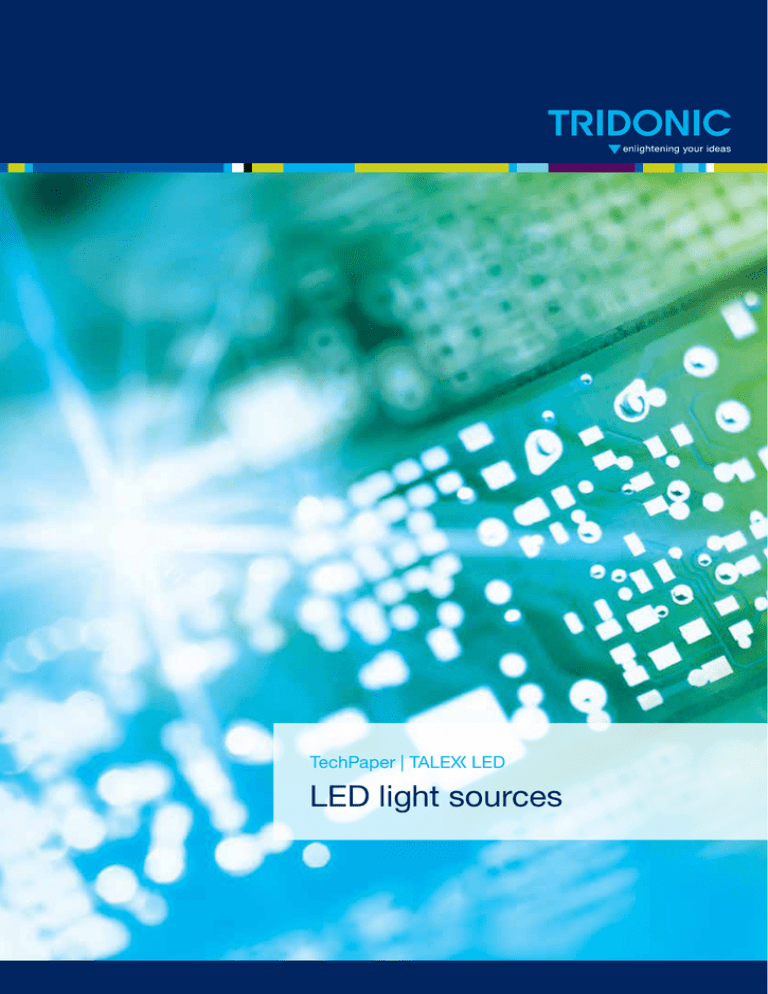
TechPaper | T LED LED light sources The light of the future LED technology Light emitting diodes (LED) are the shooting stars of the lighting scene: Tiny and extremely efficient, they are revolutionising the world of light at the start of the 21st century. They are providing new levels of lighting quality in more and more new applications. LEDs started out as coloured signal lamps but they soon outgrew this initial application. Today the LED is synonymous with the future of light and is superior in so many ways to other options. LEDs can be used in so many varied application and its versatility and variety of shapes and colours are truly impressive. LEDs provide the basis for lighting solutions that exceeds anything that has gone before. Thanks to their small size, enormous range of colours and digital dimmability they are opening up completely new applications and design opportunities. Their efficiency, durability and lack of maintenance are also helping to make LEDs the light sources of the future. The list of the positive features of LEDs is endless. The most important benefits are as follows: __ Instant flicker-free light __ Very low direct thermal output __ No IR or UV radiation in the light __ Constant colour throughout the life of the LED __ Very high luminous efficacy __ Insensitive to vibrations __ Easy disposal at end of life A big reputation Tridonic stands for supreme quality. 60 years of experience and success in the lighting industry speaks for itself. Since 1991, the company has been working intensively with LED technology in all its aspects – from complete LED system solutions, to LED modules and LED drivers. There are 130 LED experts working for Tridonic in the Technology and Research Centre in Jennersdorf alone and they are setting new standards. In addition to its in-house research and development facilities, Tridonic has entered cooperative agreements and partnerships with renowned companies and research institutions such as LG Innotek, a subsidiary of the Korean LG Group, the Technical University of Vienna, the Fraunhofer Institute in Dresden, ETH Zurich and the University of Newcastle, to name but a few. Key technological expertise at Tridonic is being strategically strengthened not only by these cooperation agreements and partnerships but also by significant investment in development, production, marketing and sales. Phosphor of high quality Tridonic uses state of the art phosphors with the highest quantum efficiency availbale on the market. All phosphors are qualified in our own testing-environment. We have the expertise to offer optimised phosphor composition for the customers need therefore we offer LED modules with different light temperatures and excellent colour renderings with high efficacy. In addition we also offer special light colours and optimised spectral tuning, e.g. for fashion or art. ___ Patent families since 2008: total 453, 75 % LED related ___ 52 % of turnover with new products (<3 years) ___ Tridonic portfolio: 32 % turnover with LED ___ Target 2015: Tridonic portfolio 50 % turnover with LED ___ R&D Spend 13/14: 9.6 % of turnover 2 3 Differences – LED layouts Chip on board (COB) versus Surface mounted device (SMD) There are two main techniques for mounting LEDs to the surface of a printed circuit board. Chip on board technology means the different components of the LED (chip, fluorescent converter, wire bond) are built together on the printed circuit board. SMD technology means the different components of the LED are pre-fabricated. The unit is soldered to the printed circuit board as a whole. The decision as to which of the two technologies is used mainly depends on the proposed application. Typically SMD is more often used for area modules whereas COB is used for spot modules. SMD Housing Board Pad Phosphor fill up Bond wire (Al, Au) Reflector Chip Pad Bond wire LED (blue) LED (blue) Phosphor fill up Thermal glue Dam SMD connectors Thermal glue Thermal Resitor PCB PCB Chip on board technology (COB) In the case of chip on board technology, “naked” unpackaged semiconductor chips, known as “dies”, are attached directly to the circuit board by means of an adhesive with high thermal conductivity and connected to the pads on the circuit board via “wire bonding”. Gold wires with cross sections in the micrometre range are used for making electrical contact. The open parts are covered with a potting compound to protect them from mechanical exposure and pollution. For this, the so-called dam and fill technique is used. First, a dam is drawn around the components with a viscous fluid. Subsequently, the intermediate space is filled with a liquid, which hardens afterwards. Surface mounted device technology (SMD) SMD LEDs are designed for automatic population of circuit boards and extremely low-profile and narrow modules. Encapsulated SMD LEDs are fixed directly onto the circuit board with adhesive. Electrical contact is made in a solder pot. These components meet the requirements of general lighting applications such as the quality of light and thermal management. The disadvantage of this technology is that the packaging and solder increase their thermal resistance. What’s more, the packing density on the LED chip is less than can be achieved with COB technology. Chip on board Excellent thermal management, as chip is directly mounted on the PCB (preferable without insulating layer). Higher mounting density of chips respectively higher light intensity possible. Mounting density of actual Tridonic modules up to approx. 30 lm/mm² (4,000 K, CRI 80, Tp = 65 °) Surface mounted device Thermal management worse than COB as additional thermal resistances existing (material of package, solderjoint, insulating layer of PCB). Mounting density of actual Tridonic modules up to approx. 1,3 lm/mm² (4,000 K, CRI 80, Tp = 65 °) Retail & Hospitality Application Office & Education Application Application of COB __ High light intensity required __ Spotlights for Retail & Hospitality Application of SMD __ Light intensity not paramount __ Main requirement is the wide illumination of a room __ Area lighting for Office & Education Optics __ Reflector or lens to achieve a small radiation pattern __ High light intensity Optics __ Diffuser necessary for mixing the single light points Parameter __ Homogenous illumination required __ COB-module with full faced encapsulation necessary Size __ tmodule SLE 60 chips on LES 15 __ 4,000 K, CRI 80 @ 26,3 W __ Luminous flux of 2,920 lm (Tp = 65 °) Size __ tmodule DLE 45 chips on LES 65 __ 4,000 K, CRI 80 @ 25 W __ Luminous flux of 3,480 lm (Tp = 65 °) t LED with COB technology t LED with SMD technology 4 5 Sophisticated light With technology rapidly evolving, we are always looking at new solutions for our existing products and the creation of new lighting systems for the future. Our components make sure you can fully exploit the light’s potential. Keeping the details in mind and the system in sight Perfect solutions are based on reliable components, each of which work with high precision and efficiency. From LED modules and LED drivers to emergency lighting and lighting control systems, Tridonic offers you a comprehensive, diverse range of products on a one-stop shop basis – to be individually combined, including complete solution packages for any application. We keep all your requirements – down to the smallest detail – in mind and the entire system in sight. Tridonic portfolio overview COB and SMD used in t products Chip on board (COB) tmodule SLE Surface mounted device (SMD) tmodule FLE tmodule DLE tchain P541/P551 For our matching dimmable and non-dimmable tdriver please visit: www.tridonic.com/setbuilder tmodule CLE tchain P561 Tridonic systems in use For demanding projects throughout the world Application example for Signage Müller pharmacy chain, Germany Customer requirements: To achieve a considerable reduction in the energy costs for lighting and to increase the maintenance intervals. At the same time, the existing and successful ambiance was to be retained. The Tridonic system solution: The existing light sources with T8, T5, low-voltage halogen, neon and high-intensity discharge lamps were replaced by highly efficient LED technology from Tridonic. The appropriate solutions, comprising light sources and drivers, were found for the ceiling, shelving and wall lighting. Depending on which light sources were replaced, the Müller chain has achieved energy savings of between 30 and 80 percent. Application example for Retail & Hospitality Morrisons supermarket chain, Bradford, UK Customer requirements: A reduction in energy costs and the same high quality of light. The Tridonic system solution: The old T8 fluorescent lamps and HF control gear have been replaced by state-of-the-art LED technology. With the aid of a total of more than 270,000 Tridonic products (including tmodule LLE 24 and tdriver LCI 70 W 300 mA) Morrisons has been able to make energy savings of up to 70 percent. This translates into annual savings of 195 tonnes of CO2 and 37,470 euros. Application example for Office & Education Dula Headquarters, Dortmund, Germany Customer requirements: The lighting should make a significant contribution to improving the energy efficiency of the building and at the same time create an inspiring and motivating work environment. The Tridonic system solution: For the lighting solution, qualities such as illuminance and glare-free light were just as important as uniform distribution of light, appropriate light colours and excellent colour rendering. These complex requirements were met by LED light engines from the Tridonic portfolio. In total, almost 1,000 tmodule QLE and SLE devices in conjunction with tdriver ECO now provide efficient light and high visual comfort in the offices, conference rooms, corridors and stairwells of the Dula Headquarters. 6 7 Support and advice from a single source We will help you to create lighting solutions that are unbeatable in terms of economy and functionality, in accordance with our slogan "we devote all our energy to your light". tengine DLE tengine DLE Integrated tengine CLE tengine CLE Integrated tengine SLE tengine FLE tengine LLE tengine QLE As an international company, Tridonic is represented worldwide by 30 branch offices and partners in 73 countries. Headquarters Tridonic GmbH & Co KG Färbergasse 15 | 6851 Dornbirn, Austria T +43 5572 395-0 | F +43 5572 20176 www.tridonic.com | sales@tridonic.com 04/15 Light you want to follow. Subject to change without notice. Errors and omission excepted.
